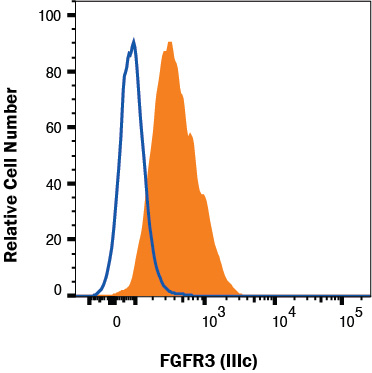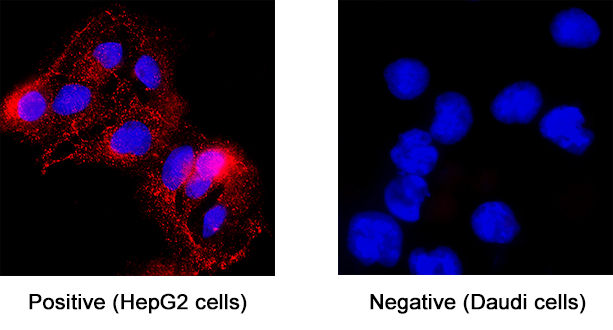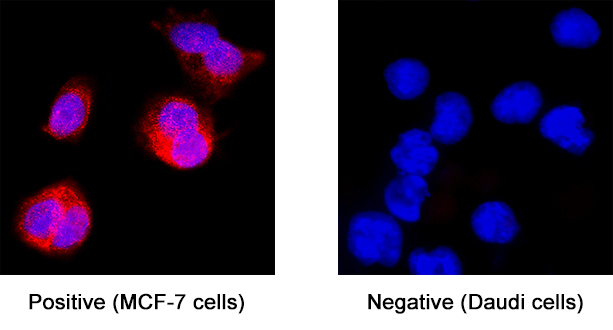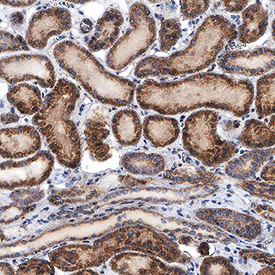Human FGFR3 (IIIc) Antibody
Human FGFR3 (IIIc) Antibody Summary
Applications
Please Note: Optimal dilutions should be determined by each laboratory for each application. General Protocols are available in the Technical Information section on our website.
Scientific Data
 View Larger
View Larger
Detection of FGFR3 (IIIc) in HepG2 Human Cell Line by Flow Cytometry. HepG2 human hepatocellular carcinoma cell line was stained with Mouse Anti-Human FGFR3 (IIIc) Monoclonal Antibody (Catalog # MAB7662, filled histogram) or isotype control antibody (MAB002, open histogram), followed by Allophycocyanin-conjugated Anti-Mouse IgG F(ab')2Secondary Antibody (F0101B). Staining was performed using our Staining Membrane-associated Proteins protocol.
 View Larger
View Larger
FGFR3 in HepG2 Human Cell Line. FGFR3 was detected in immersion fixed HepG2 human hepatocellular carcinoma cell line (positive staining) and Daudi human Burkitt's lymphoma cell line (negative staining) using Mouse Anti-Human FGFR3 (IIIc) Monoclonal Antibody (Catalog # MAB7662) at 25 µg/mL for 3 hours at room temperature. Cells were stained using the NorthernLights™ 557-conjugated Anti-Mouse IgG Secondary Antibody (red; NL007) and counterstained with DAPI (blue). Specific staining was localized to cytoplasm. Staining was performed using our protocol for Fluorescent ICC Staining of Non-adherent Cells.
 View Larger
View Larger
FGFR3 in MCF‑7 Human Cell Line. FGFR3 was detected in immersion fixed MCF‑7 human breast cancer cell line (positive staining) and Daudi human Burkitt's lymphoma cell line (negative staining) using Mouse Anti-Human FGFR3 (IIIc) Monoclonal Antibody (Catalog # MAB7662) at 25 µg/mL for 3 hours at room temperature. Cells were stained using the NorthernLights™ 557-conjugated Anti-Mouse IgG Secondary Antibody (red; NL007) and counterstained with DAPI (blue). Specific staining was localized to cytoplasm. Staining was performed using our protocol for Fluorescent ICC Staining of Non-adherent Cells.
 View Larger
View Larger
FGF R3 in Human Kidney. FGF R3 was detected in immersion fixed paraffin-embedded sections of human kidney using Mouse Anti-Human FGF R3 (IIIc) Monoclonal Antibody (Catalog # MAB7662) at 8 µg/mL for 1 hour at room temperature followed by incubation with the Anti-Mouse IgG VisUCyte™ HRP Polymer Antibody (VC001). Before incubation with the primary antibody, tissue was subjected to heat-induced epitope retrieval using Antigen Retrieval Reagent-Basic (CTS013). Tissue was stained using DAB (brown) and counterstained with hematoxylin (blue). Specific staining was localized to cytoplasm and nuclei. View our protocol for IHC Staining with VisUCyte HRP Polymer Detection Reagents.
Reconstitution Calculator
Preparation and Storage
- 12 months from date of receipt, -20 to -70 degreesC as supplied. 1 month, 2 to 8 degreesC under sterile conditions after reconstitution. 6 months, -20 to -70 degreesC under sterile conditions after reconstitution.
Background: FGFR3
FGF R3 is a type I transmembrane tyrosine kinase receptor that binds FGF ligands along with heparin or heparin sulfate proteoglycans as co-factors. A segment of the membrane proximal Ig-like domain can be encoded by two different exons resulting in (IIIb) or (IIIc) isoforms. The IIIb or IIIc isoforms recognize FGF-1, -2, -4, -8b, -8e, -8f, -9 and -17b. FGF R3 plays a role in skeletal, brain, lung, intestine, kidney, and skin development.
Product Datasheets
Citations for Human FGFR3 (IIIc) Antibody
R&D Systems personnel manually curate a database that contains references using R&D Systems products. The data collected includes not only links to publications in PubMed, but also provides information about sample types, species, and experimental conditions.
2
Citations: Showing 1 - 2
Filter your results:
Filter by:
-
In vitro and in vivo characterization of Recifercept, a soluble fibroblast growth factor receptor 3, as treatment for achondroplasia
Authors: D Gonçalves, G Rignol, P Dellugat, G Hartmann, S Sarrazy Ga, J Stavenhage, L Santarelli, E Gouze, C Czech
PLoS ONE, 2020-12-28;15(12):e0244368.
Species: Mouse
Sample Types: Serum
Applications: ELISA Capture -
Alternative splicing of fibroblast growth factor receptor 3 produces a secreted isoform that inhibits fibroblast growth factor-induced proliferation and is repressed in urothelial carcinoma cell lines.
Authors: Tomlinson DC, L'Hôte CG, Kennedy W, Pitt E, Knowles MA
Cancer Res., 2005-11-15;65(22):10441-9.
Species: Human
Sample Types: Cell Lysates
Applications: Immunoprecipitation
FAQs
No product specific FAQs exist for this product, however you may
View all Antibody FAQsReviews for Human FGFR3 (IIIc) Antibody
There are currently no reviews for this product. Be the first to review Human FGFR3 (IIIc) Antibody and earn rewards!
Have you used Human FGFR3 (IIIc) Antibody?
Submit a review and receive an Amazon gift card.
$25/€18/£15/$25CAN/¥75 Yuan/¥2500 Yen for a review with an image
$10/€7/£6/$10 CAD/¥70 Yuan/¥1110 Yen for a review without an image





